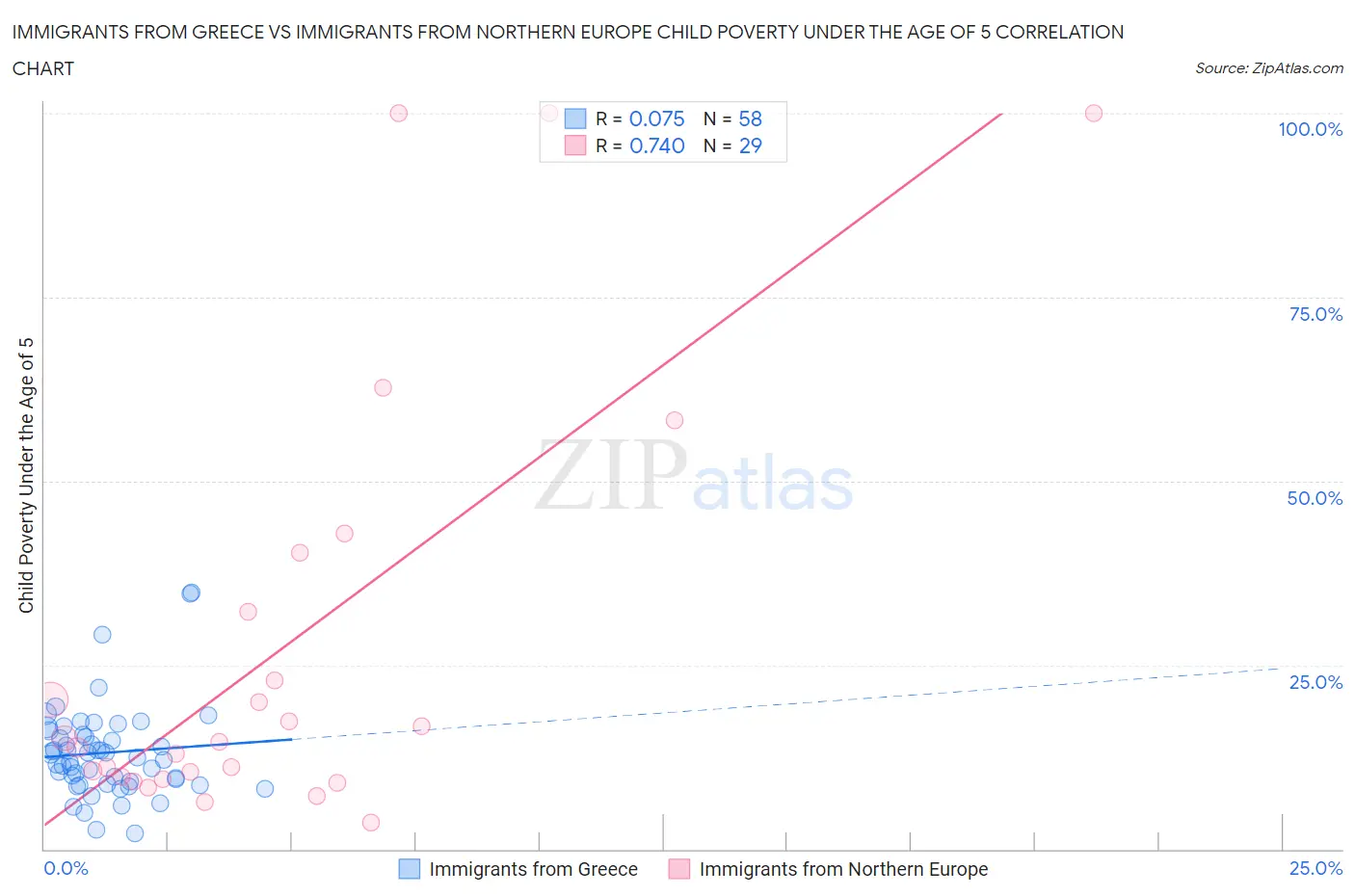Immigrants from Greece vs Immigrants from Northern Europe Child Poverty Under the Age of 5
COMPARE
Immigrants from Greece
Immigrants from Northern Europe
Child Poverty Under the Age of 5
Child Poverty Under the Age of 5 Comparison
Immigrants from Greece
Immigrants from Northern Europe
14.7%
CHILD POVERTY UNDER THE AGE OF 5
99.7/ 100
METRIC RATING
43rd/ 347
METRIC RANK
14.8%
CHILD POVERTY UNDER THE AGE OF 5
99.6/ 100
METRIC RATING
50th/ 347
METRIC RANK
Immigrants from Greece vs Immigrants from Northern Europe Child Poverty Under the Age of 5 Correlation Chart
The statistical analysis conducted on geographies consisting of 208,661,628 people shows a slight positive correlation between the proportion of Immigrants from Greece and poverty level among children under the age of 5 in the United States with a correlation coefficient (R) of 0.075 and weighted average of 14.7%. Similarly, the statistical analysis conducted on geographies consisting of 450,553,782 people shows a strong positive correlation between the proportion of Immigrants from Northern Europe and poverty level among children under the age of 5 in the United States with a correlation coefficient (R) of 0.740 and weighted average of 14.8%, a difference of 0.83%.

Child Poverty Under the Age of 5 Correlation Summary
| Measurement | Immigrants from Greece | Immigrants from Northern Europe |
| Minimum | 2.1% | 3.6% |
| Maximum | 34.8% | 100.0% |
| Range | 32.7% | 96.4% |
| Mean | 13.1% | 27.5% |
| Median | 12.7% | 14.6% |
| Interquartile 25% (IQ1) | 9.2% | 9.7% |
| Interquartile 75% (IQ3) | 15.5% | 36.2% |
| Interquartile Range (IQR) | 6.3% | 26.6% |
| Standard Deviation (Sample) | 6.2% | 29.1% |
| Standard Deviation (Population) | 6.2% | 28.6% |
Demographics Similar to Immigrants from Greece and Immigrants from Northern Europe by Child Poverty Under the Age of 5
In terms of child poverty under the age of 5, the demographic groups most similar to Immigrants from Greece are Soviet Union (14.7%, a difference of 0.0%), Immigrants from Philippines (14.7%, a difference of 0.13%), Immigrants from Belarus (14.7%, a difference of 0.16%), Laotian (14.7%, a difference of 0.26%), and Immigrants from Australia (14.6%, a difference of 0.28%). Similarly, the demographic groups most similar to Immigrants from Northern Europe are Estonian (14.8%, a difference of 0.040%), Immigrants from Bulgaria (14.8%, a difference of 0.090%), Immigrants from Czechoslovakia (14.8%, a difference of 0.24%), Russian (14.8%, a difference of 0.35%), and Tsimshian (14.7%, a difference of 0.49%).
| Demographics | Rating | Rank | Child Poverty Under the Age of 5 |
| Maltese | 99.8 /100 | #36 | Exceptional 14.5% |
| Turks | 99.7 /100 | #37 | Exceptional 14.6% |
| Eastern Europeans | 99.7 /100 | #38 | Exceptional 14.6% |
| Norwegians | 99.7 /100 | #39 | Exceptional 14.6% |
| Immigrants | Australia | 99.7 /100 | #40 | Exceptional 14.6% |
| Immigrants | Belarus | 99.7 /100 | #41 | Exceptional 14.7% |
| Soviet Union | 99.7 /100 | #42 | Exceptional 14.7% |
| Immigrants | Greece | 99.7 /100 | #43 | Exceptional 14.7% |
| Immigrants | Philippines | 99.7 /100 | #44 | Exceptional 14.7% |
| Laotians | 99.6 /100 | #45 | Exceptional 14.7% |
| Tsimshian | 99.6 /100 | #46 | Exceptional 14.7% |
| Russians | 99.6 /100 | #47 | Exceptional 14.8% |
| Immigrants | Czechoslovakia | 99.6 /100 | #48 | Exceptional 14.8% |
| Immigrants | Bulgaria | 99.6 /100 | #49 | Exceptional 14.8% |
| Immigrants | Northern Europe | 99.6 /100 | #50 | Exceptional 14.8% |
| Estonians | 99.6 /100 | #51 | Exceptional 14.8% |
| Immigrants | Serbia | 99.5 /100 | #52 | Exceptional 14.9% |
| Luxembourgers | 99.4 /100 | #53 | Exceptional 14.9% |
| Immigrants | Israel | 99.4 /100 | #54 | Exceptional 14.9% |
| Danes | 99.4 /100 | #55 | Exceptional 14.9% |
| Immigrants | Pakistan | 99.4 /100 | #56 | Exceptional 14.9% |